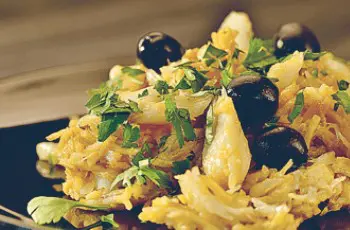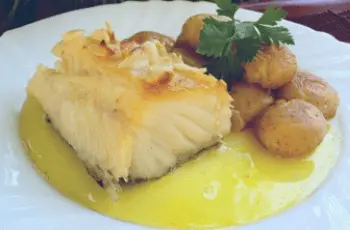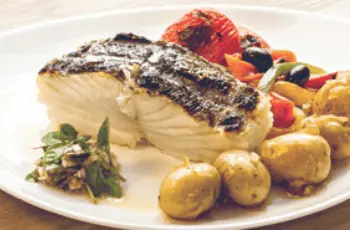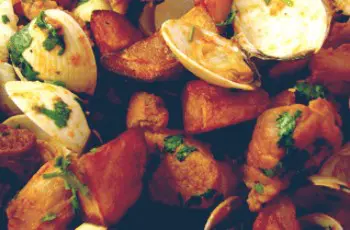Portuguese gastronomy can be classified as Mediterranean cuisine and, like Mediterranean cuisine, the three pillars of Portuguese food are bread, wine and oil. However, the influence of former Portuguese colonies in Asia, Africa and America (Brazilian cuisine) is also noticeable, especially in the use of spices, including piri piri, paprika and cinnamon. There are also influences from Berber cuisine (mainly Moroccan cuisine). A curious note of comparison with other Mediterranean cuisines is the almost complete lack of current knowledge of lentils, aubergines or cardoon. Garlic is widely used, some spices in the form of herbs such as coriander or coriander and parsley, saffron or even ginger are used in traditional recipes. Olives and cheese are served as appetizers in restaurants and on special occasions. It is very common to serve soup before the main course, to accompany meat dishes with white rice and fish dishes with boiled potatoes. It is not uncommon for rice and potatoes to be presented together in the same dish. Green kale is ubiquitous in home gardens. The main ingredients are: cabbage, potato, rice.
Bread
Bread (pão) is one of the staples of Portuguese cuisine. Processing is not limited to the use of wheat flour, but corn flour is frequently used (northern Portugal). Bread is part of very traditional dishes such as açordas and migas à alentejana and torricado. Among the best-known breads in the far east are the Broa de Avintes. Other breads are the Fogaça, the “caralhotas” of Almeirim (round, medium-sized breads, especially appreciated when fresh from the oven), the “pão-com-chouriço” (similar to the Asturian “preñaos”, eaten at fairs and festivals, they have a chouriço inside), the folares (typical of Easter), etc. In northern Portugal, it often refers to ‘balls’ (‘bôlas’) which are breads with minced meat inside (in Trás-os-Montes) or round, compact breads served with sardinhas or meat (as can be found in some parts of Minho).
Meat
In the field of meat, a lot of pork is eaten and sausages (Enchidos) are made, such as Chouriço, ham (called presunto, often smoke-cured, with a very characteristic taste). As in the cuisine of Spain, the matança do porco (slaughter), which consists of the slaughter of a pig and its subsequent processing for the feeding of a family unit, is traditional. The chanfana uses goat meat cooked in wine. In the field of poultry, there is rice with duck and canja a doentes, a soup with chicken meat. Portuguese steak is made by coating the meat with garlic paste. Small game meats are usually coelho (rabbit), sometimes prepared with Vinhadalhos. The rabbit to the huntress (coelho à caçadora).
Fish
In the field of fish (Peixe in Portuguese), the tradition of eating fresh fish, often cooked in the simplest way, grilled and seasoned with olive oil, is noteworthy. It is also prepared in a variety of rice dishes or potato stews called caldeiradas and cataplanas. The espetos de peixes (espetada), which are a kind of skewer, are very well known. Cuttlefish and squid (called lulas or lulinhas) are very popular. Octopus and various seafood are also eaten in the south of Portugal, especially lobster and lobster, often served in beer gardens grilled or with scrambled eggs. Seafood is relatively abundant in coastal areas.
Codfish
The king fish of Portuguese cuisine is imported and consumed in large quantities.2 Cod (Bacalhau) is usually cured by salting and the big trick is to know how to desalinate it. Los cocineros portugueses dicen que existen 365 recetas diferentes para este pescado (una para cada día del año). Some of the most popular recipes are: Bacalhau à Brás, Bacalhau à Gomes de Sá, Bacalhau com todos, stewed cod, in cakes or in the form of delicious pataniscas, in delicate fritters that can accompany a juicy feijoada or rice and black bean stew.
Cheeses
Portugal’s cheeses protected by designation of origin are as follows:
Queijo de Azeitão
Queijo de Nisa
Queijo Rabaçal
Queijo Serra da Estrela
Queijo de Cabra Transmontano
Queijo do Pico
Queijo São Jorge
Queijo Terrincho
Queijo de Évora
Queijo mestiço de Tolosa
Queijo Serpa
Queijos da Beira Baixa
Wines
The wines are well known outside the borders of Portugal, they are produced in almost all the territory and stand out the green wines of the north which are usually white and young wines, the Oporto (produced in the city of Vila Nova de Gaia), Madeira, wine of Carcavelos, or the muscatel of Setúbal, red of Borba or Dão, among others. Classified as the best on the planet.
Typical dishes

Bacalhau à Brás
Cod is one of the country’s most typical dishes. One of them, the best known, is the famous ‘bacalhao à Brás’, which as many of you already know is made of cod with egg and potatoes. A delicacy of Portuguese cuisine.

Bacalhau à lagareiro
This is another of the most typical ways of preparing cod. The fundamental base is a good Portuguese virgin olive oil. In fact, it is essential that the cod literally floats in oil. Other: Baked potato with skin and garlic. Recently a new version has been created but with octopus (polvo à lagareiro).

Bifana
Bifana is one of the classics of Portuguese fast food. It is simply a steak sandwich. Something quick, good and quite cheap in any café or pastry shop in Lisbon. As a tip, ask them to add a bit of mustard… Great!

Bacalhau grelhado
Cod as well as any type of meat or vegetable ‘grelhado’ means grilled. This might be the third most typical way to eat this fish here in Lisbon. It tends to be served with potatoes and vegetables (although each Portuguese village has its own version).

Porco à alentejana
It is a typical food from Alentejo but also very popular in Lisbon. It consists of pieces of pork meat tempered in spices and then cooked with clams and served on a potato dish. It is one of the best fusions of land and sea gastronomy. Be careful for those who are not very fond of coriander, as it usually contains a lot of it (if you don’t like it, tell the waiter: ‘sem coentro’, i.e. without coriander).

Francesinha
The francesinha is a typical dish from Porto and the area of Viana do Castelo. Even so, it can be tasted in many places in the Portuguese capital. It is a sandwich filled with various meats (steaks, sausages, chorizo and ham) and covered with slices of cheese and a sauce with tomato, beer and some piri piri au gratin. It is usually served with a fried egg on top and a portion of potatoes. Along with the bifana, it is the ‘fast food’ par excellence Made in Portugal.

Cream cakes (Pastel de Belém)
One of Lisbon’s most traditional desserts is the pasteles de Belém. You can find them in any Portuguese pastry shop, but the original ones can only be found in Pastéis de Belém, in the Belém district. If you want to try them and learn all about their history, don’t hesitate to join our Belém tour, every day at 10:30 am at Praça do Comércio.


